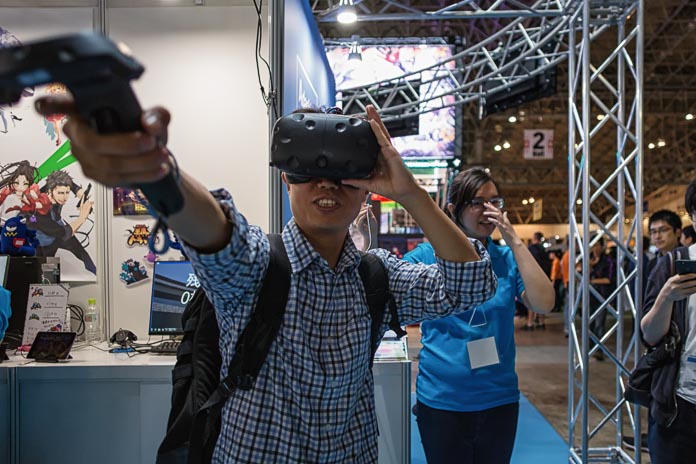Stepping through the doors of Tokyo Game Show is setting foot on hallowed ground. Since its inception 21 years ago, this conference has grown to over 270,000 attendees, making it one of Asia’s largest gaming conventions. For innumerable gamers worldwide, attending TGS has become as much a required pilgrimage as Gamescom. And it’s easy to see why: this convention is twice the size of PAX West, sprawling across 11 halls, two convention centers, and over 850,000 square feet. There’s an enormous Capcom booth, an esports arena, and even a dedicated area for dating sims, without which no Japanese gaming convention would be complete.
But I was at TGS for a specific reason. This year’s theme, “Reality Unlocked,” was a nod to TGS’s renewed emphasis on all things virtual, augmented, and mixed reality. Of the 332 exhibitors, over 42 were dedicated to VR, MR, and AR. If your eye was on Oculus, Vive, Hololens, or any number of VR startups, this was the definitive place to try them. I spent two solid days immersing myself in as many of these experiences as possible, and the VR headset imprints on my face almost became permanent. Here are some of the momost unique, stand out, and just plain strange “Reality Unlocked” moments from TGS 2017.
Roaming free in virtual reality
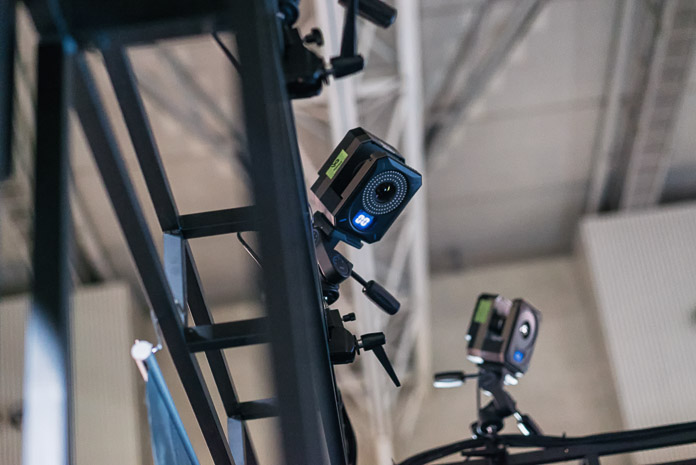
 Realis combines infrared cameras with motion capture dots for free-roaming VR.
Realis combines infrared cameras with motion capture dots for free-roaming VR.
Realis’ VR setup caught my eye from the start. Their technology combines off-the-shelf VR backpacks with a proprietary motion capture system. Infrared cameras ringed the booth and reflective mocap dots were attached to the backpacks, VR headsets, and controllers. The result is a free-roaming VR setup that’s contained to what players are wearing and carrying. Without wires running to a wall, players are free to walk around within view of the mocap cameras. Best of all, there’s nothing to trip over.
Realis was demoing two different games: Snow Days, a PvP robot snowball fight, and The Lost Passage, a two-player cooperative escape room. Seeing this was especially exciting, given I had the chance to try a seated VR escape room earlier this year.
Snowballs vs. Robots
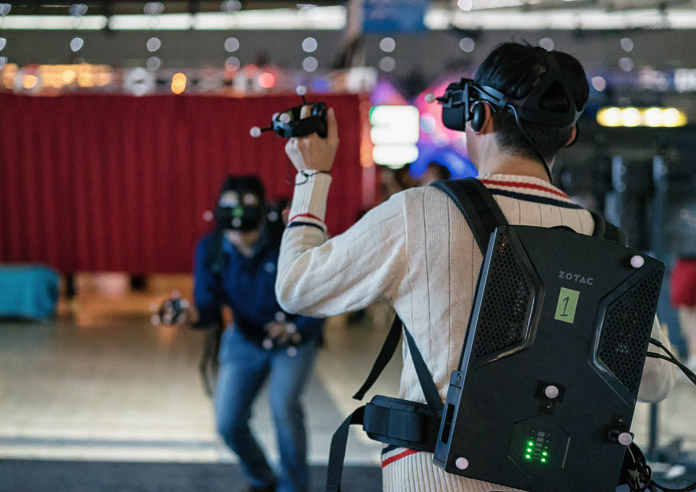 Players chuck snowballs at each other in a virtual battle.
Players chuck snowballs at each other in a virtual battle.
Snow Days was uproariously good fun. Imagine all the joy of smashing snowballs on your friends, but add in a digital blizzard, subtract the biting cold, and turn yourself into an EVE-style robot (yes, just like the movie Wall-E). And no need to make snowballs; they’re already piled up. Simply scoop up your ammo and chuck it at your robot opponent, where it explodes on impact in a satisfying burst of sparks.
I’m used to being on a short cable tether, so I forgot I could walk around until my opponent ran up and lobbed a snowball right in my face. The ability to crouch, walk, and strafe completely naturally makes the free-movement in Snow Days especially fantastic. Even the ring-shaped Oculus controllers made grabbing and throwing snowballs feel more natural. With some extra physics and amped up graphics, this is a game could easily become a favorite for me.
Escaping the Lost Passage
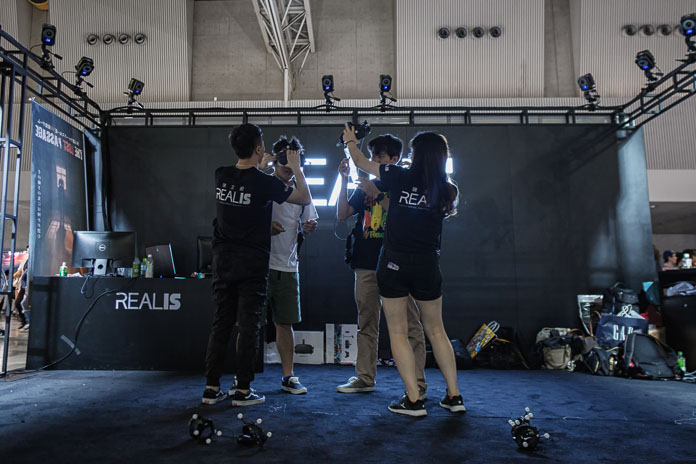
Players gear up for the VR escape room with backpacks and Oculus headsets.
Your intrepid hero is no fan of jump scares on the very best days, so seeing The Lost Passage was a horror escape room gave me pause. Know this, dear readers: I strapped on that headset for the greater good. Thankfully, only one creepy toy basket moved of its own volition, and I only screamed three (okay, five) times.
In this game, players became floating, semi-transparent blue torsos, picked up lanterns to illuminate their way, and wandered through a creepy hallway, bedroom, and bathroom. The VR enabled some terrifying shenanigans that real-life escape rooms can’t pull off: a bathroom door fell away, leaving us teetering on a dark precipice, and a bathtub turned into a howling demonic portal. The free-roaming gameplay is a nice touch when you’re sneaking through haunted hallways, but without any clear information-sharing or puzzle-solving, this game merely hints at VR escape rooms’ future potential.
For both games, the tech was the big standout. The experience was powered by a lightweight, battery-powered desktop with a battery indicator LEDs and special heat ventilation packed into a backpack with padded straps. At 8.6 lbs, it was heavier than Republic of Gamers’ lightweight VR laptops, yet still barely noticeable. With feather-light laptops like the 4.9-lb ROG Zephyrus already available and VR-ready, the tech required for VR is being squeezed into smaller, neater packages, which can only be good news for free-roaming VR.
Mixing the real and the virtual
If VR backpacks unlock the door to untethered experiences, mobile VR, where players shed heavy headsets and cumbersome tethers for the cell phones in their pockets, offers total liberation. Paired with Google’s Daydream headset, the Zenfone AR offers an experience that is compact, cordless, and computer-free, and the total package weighs in at less than a pound. This is certainly why mobile head-mounted displays of all varieties featured prominently into TGS’ mixed reality experiences, even with their limitations on free-movement. In fact, rather than being constrained by mobile VR’s seated gameplay, resourceful developers are using it to create completely unique experiences.
Trapped on a toilet
 Panic on the Toilet Bowl uses mobile VR and a bathroom set to create an immersive and creepy bathroom escape experience.
Panic on the Toilet Bowl uses mobile VR and a bathroom set to create an immersive and creepy bathroom escape experience.
Sitting on a toilet with a VR headset would draw attention anywhere, but even more so in a packed exhibition hall. Six students from Vantan Design Institute developed Panic on the Toilet Bowl (パニック オン ザ 便器) in a month, but they still found time to build a tiny bathroom to serve as a set for their game at TGS.
To begin, you enter through the bathroom “door,” strap on the headset, and sit down on the porcelain throne. In-game, I quickly saw why one designer described it as a “crazy” experience. Plunged into darkness in the dingy bathroom of what looked to be a dive bar, I turned my head and came eye-to-teeth with a saw blade. A camera observed from the ceiling, ever-watching with a slow-blinking red eye. To get out of there, I had to enter the right numbers on a digital keypad mounted on the door. If I ran out of time, well… that’s what the saw blade was for.
But Panic on the Toilet Bowl isn’t a single-player game. Whoever’s standing outside the real-world bathroom door is responsible for helping you find the right numbers, and their mistakes mean your head. If you’re the kind of person who thinks Keep Talking and Nobody Explodes isn’t intense enough, this is the game for you.
It may seem gimmicky, but the toilet and tiny, fake bathroom set the stage perfectly. I completely forgot I was in the middle of a busy convention and not a creepy murder-bathroom. And that, after all, is the beauty of VR. Why endure conference crowds when there are hundreds of mobile VR apps and games, all enjoyable from the comfort of your couch with relatively little equipment?
Space racing for adrenaline junkies
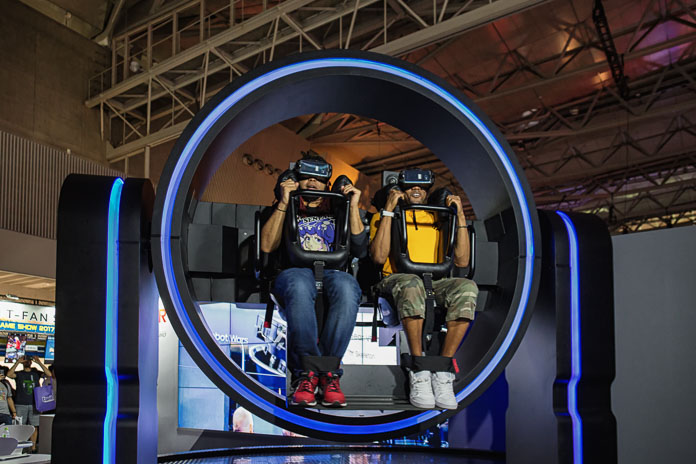 Gyro VR takes theme park rides to the next level with mobile VR.
Gyro VR takes theme park rides to the next level with mobile VR.
Mobile VR is often a seated experience because it lacks the motion sensors necessary to track your movements and extrapolate your position in the room. Gyro VR provides a workaround by moving the whole room. Kind of. This futuristic, bright blue ring was distinctly visible across the exhibition hall as it spun, tilted, and flipped riders through a digital space race.
Gyro VR is part theme park ride, part video game, all Tron. Passengers are strapped into rollercoaster-style seats within a black and blue glowing ring that’s so slick, it could be a light cycle. The ring itself moves at fairly normal speeds, but the in-game space racers whipped past asteroids and blasted into hyperspace at dizzying rates. Because human brains are excellent at matching sensations to what they see, if the game motion mirrors and amplifies the Gyro’s movements, it can actually feel as extreme as some roller coasters.
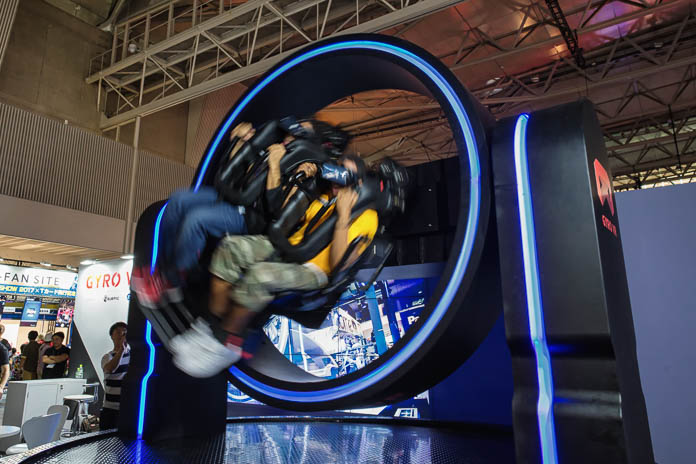 Riders flip upside down as the Gyro VR spins them through a space racing track.
Riders flip upside down as the Gyro VR spins them through a space racing track.
The trick here is syncing the headset and ride. Sales VP Andy Kim explained: “In [the attractions market], there are two kinds of players. The first one is hardware makers, the second is content makers. When [separate companies] try to work together, it’s not easy synchronizing the two.”
Because his company develops both the hardware and software, they’re uniquely positioned to make everything seamless, right down to the vents puffing air in riders’ faces when they blast through digital airlocks. With units already in South Korea and others shipping throughout Asia, chances are you’ll be hearing more about Gyro VR soon.
Honorable mentions: Virtual overload
Some TGS exhibitors mixed the real and virtual, creating new and sometimes-bizarre sensory experiences. These didn’t feel polished enough to make it into the top recommendations, but they deserve a nod. If you think you’ve seen everything mixed and augmented reality, think again.
Wake up and smell the coffee
Vaqso’s booth was mobbed with people wanting to try the latest in sensory VR technology. The candy bar-sized device magnetically attaches onto VR headsets, holds up to five scent cartridges, and programmatically diffuses smells using a tiny fan.
This theoretically means the device can emit coffee, ice cream, and other food scents when you virtually interact with them. Clearly not wanting to pass up a good dating sim scenario, they also heavily advertised the ability to diffuse “person scent,” which is really just perfume or cologne.
But with the Oculus on my face, it was immediately clear that the porous foam gasket had sucked up every scent from each past user. Everything reeked of super-sweet perfume and candy. Any smells wafting in front of my nose were overpowered by this cloying chemical cocktail clinging to the headset.
In spite its failings, the Vaqso is still cool enough on concept alone, and anyone who loves the idea of Smell-O-Vision will understand why the concept of Smell-O-VR is so appealing. I’m holding out hope that some other VR scent device soon proves itself worthy (here’s looking at you, Nosulus).
Long walks on the digital beach
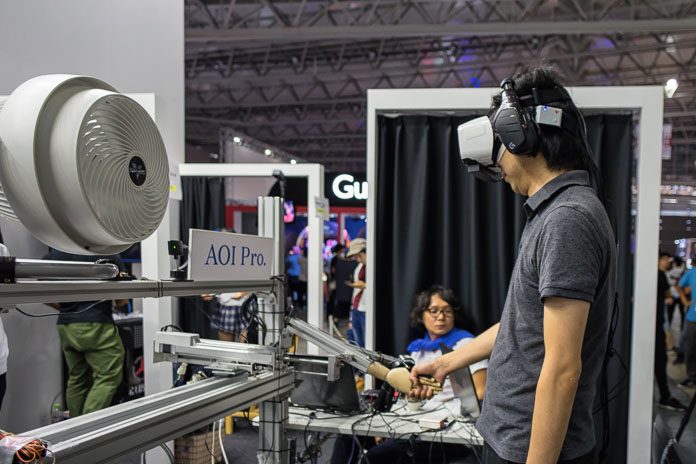
The adjacent AOI Pro booth looked like an android training area straight from science fiction: a manual treadmill, a sliding mannequin hand on a metal track, a fan, and a water misting machine all working together as part of a singular unit.
All became clear in time. As their VR video moved along a beach, the real-life player walked on the treadmill. As a virtual woman reached out to grab their hand, the mannequin’s hand slid on the track, tugging the player along.
The breeze picked up in the virtual world, and the fan gently began whirring. And as sea spray was flung from the digital ocean waves, the mist machine spritzed water. Yes, they actually replicated everything about walking along the beach, save for the sand and the scent of the sea air. Everything was perfectly synced between the video and the players’ movements. Who needs to drive out to the coast?
For now, this experience, dubbed “Wonderful World – VR Private Tour,” is purely experimental and requires computer tethering, but it’s an ambitious peek at what VR could be in future, replicating the great outdoors inside the confines of a convention center.
Augmented hide and go seek
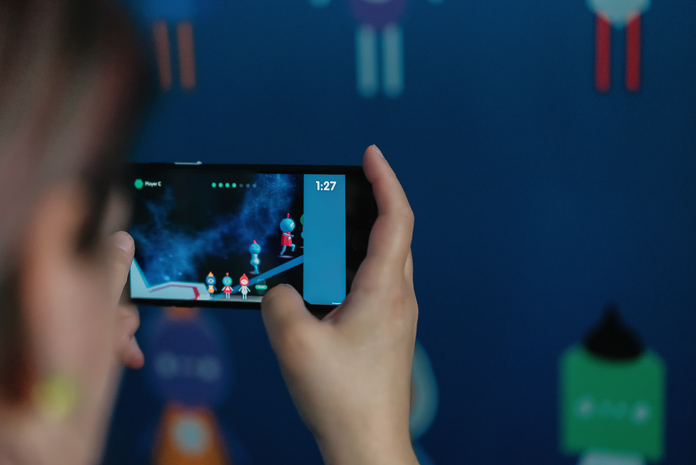 Togater creates a beautiful AR world filled with colorful creatures.
Togater creates a beautiful AR world filled with colorful creatures.
Augmented reality was surprisingly thin on the ground at TGS. One of the few AR experiences was Togater, a game with Monument Valley-aesthetics and a “Where’s Waldo” premise. Point your phone at the wall and a tiny world with dizzying M.C. Escher-style levels springs into existence. Your job is finding and collecting colorful characters called “Dicers.”
While it was lovely watching the wandering Dicers, the game had some limitations. I’ll admit that I’ve been spoiled by Project Tango’s excellent spatial awareness. While the Zenfone AR’s TriCam array, complete with three dimensional depth-sensing camera, is capable of recognizing everything in a room and turning furniture into interactive game objects, Togater’s world was limited to the booth’s flat blue backdrop, and acted more like a window into another dimension. And because it’s AR, players still had to move their bodies and phones to “zoom in” on the 3D world. This meant multiple people came dangerously close to impact as they converged toward the same wall. Ah, well. The hazard of new experiences is they’re not all magical.
Unlocking VR’s future
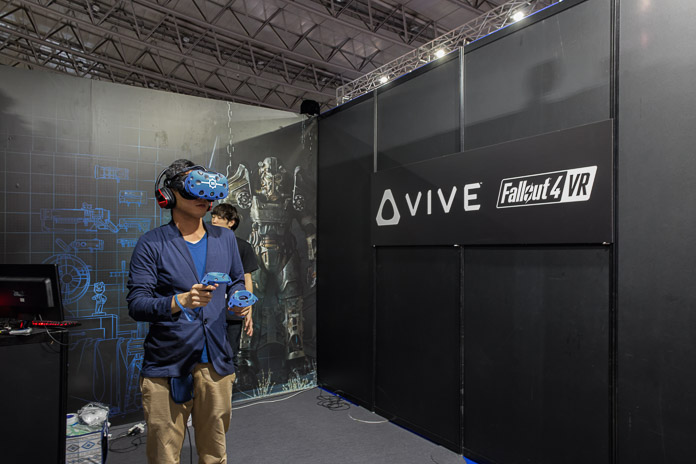 Top: A gamer flings his arm forward in VR. Bottom: Fallout 4 VR was highly anticipated, but plenty of indie experiences impressed at TGS.
Top: A gamer flings his arm forward in VR. Bottom: Fallout 4 VR was highly anticipated, but plenty of indie experiences impressed at TGS.
It’s clear why TGS decided to focus on “Reality Unlocked” this year: with increasingly powerful and lightweight VR and AR devices, developing unique and creative experiences is becoming the new norm. Beyond highly-anticipated headliners like Fallout 4 VR, an inspiring number of independent hardware and software teams showcased their tech at the Tokyo Game Show. From snowball fights to toilet escape rooms, they were all a blast.
You don’t need to attend a big show like TGS to take your first steps into worlds unknown, though. The Zenfone AR is an amazing introduction, supporting both VR and AR with Google Daydream and Tango, and there are hundreds of apps available on the Play Store from big names like the Discovery Channel to indie developers. If you’re ready to go all-in on the full-room experience, we love the small footprint of the Oculus-ready GR8 II, as well as the ultra-lightweight ROG Zephyrus. Both are capable of serving up beautifully immersive VR experiences via the HTC Vive and Oculus Rift.
Whether you go mobile or tethered, VR, AR, and MR aren’t going anywhere. Developers have just barely scratched the surface, and next year’s TGS will surely have even better experiences in store. We can’t wait to see what’s next.
 TGS 2017 ended with a spectacular sunset over Makuhari Messe convention center.
TGS 2017 ended with a spectacular sunset over Makuhari Messe convention center.
By Kimberly Koenig


